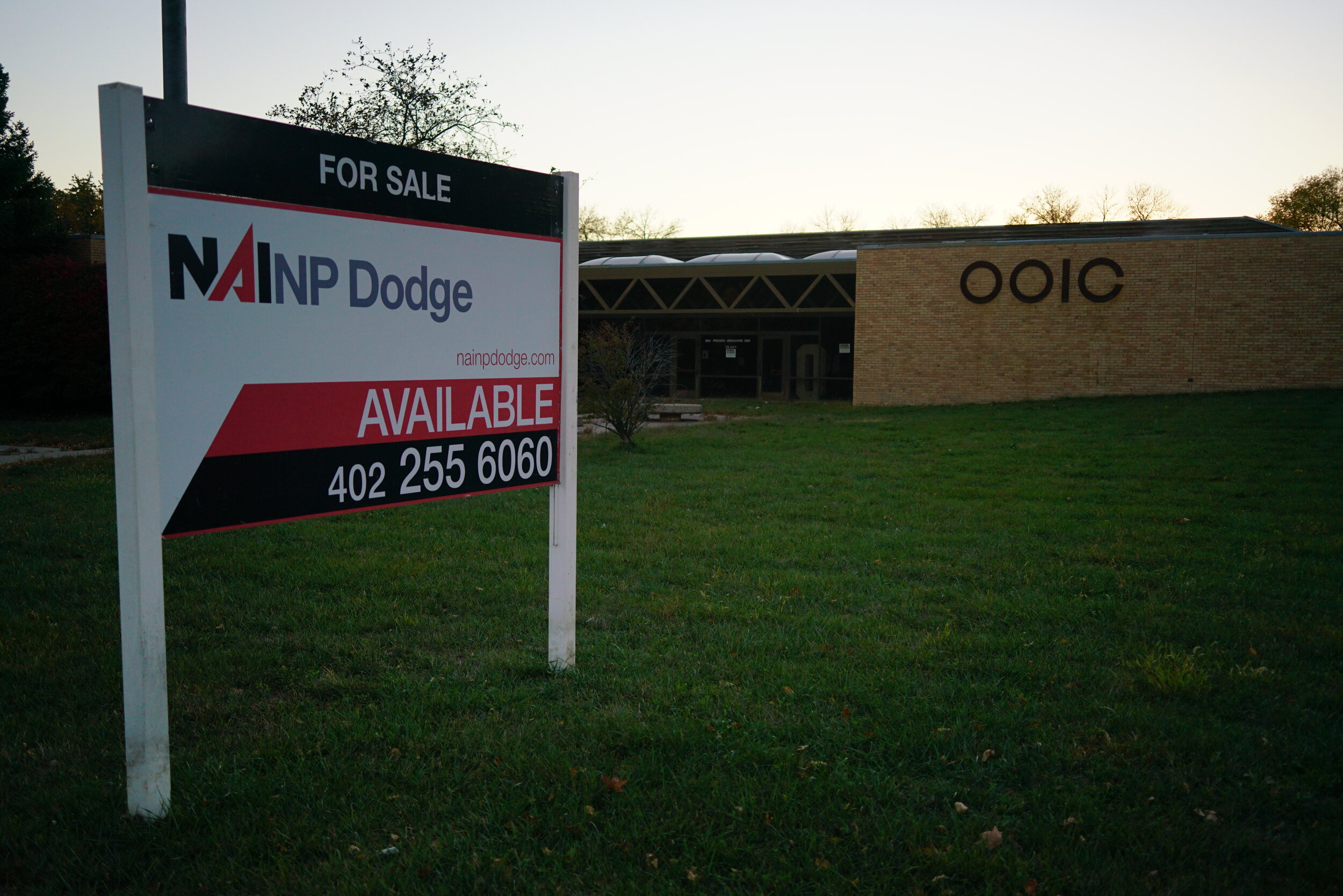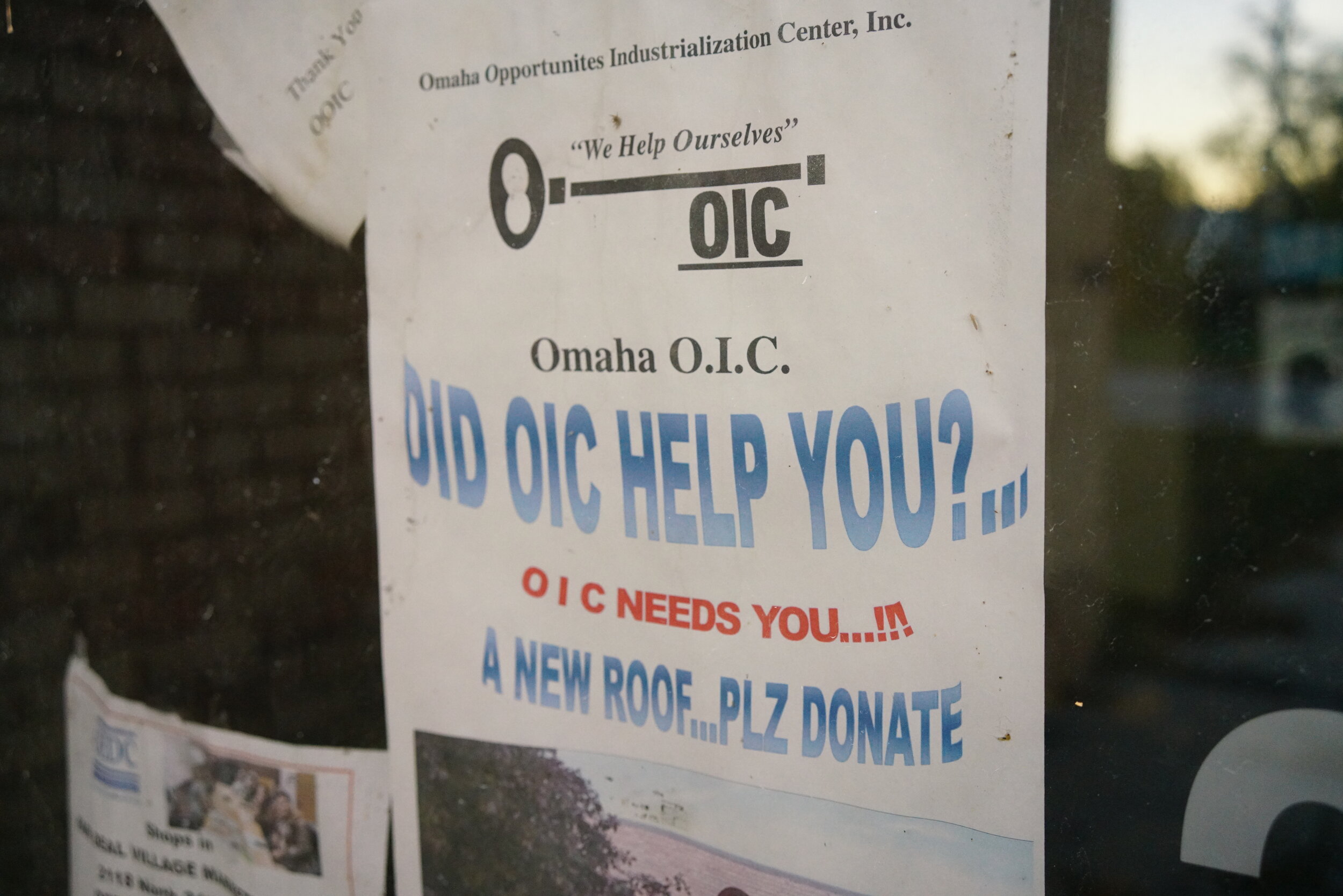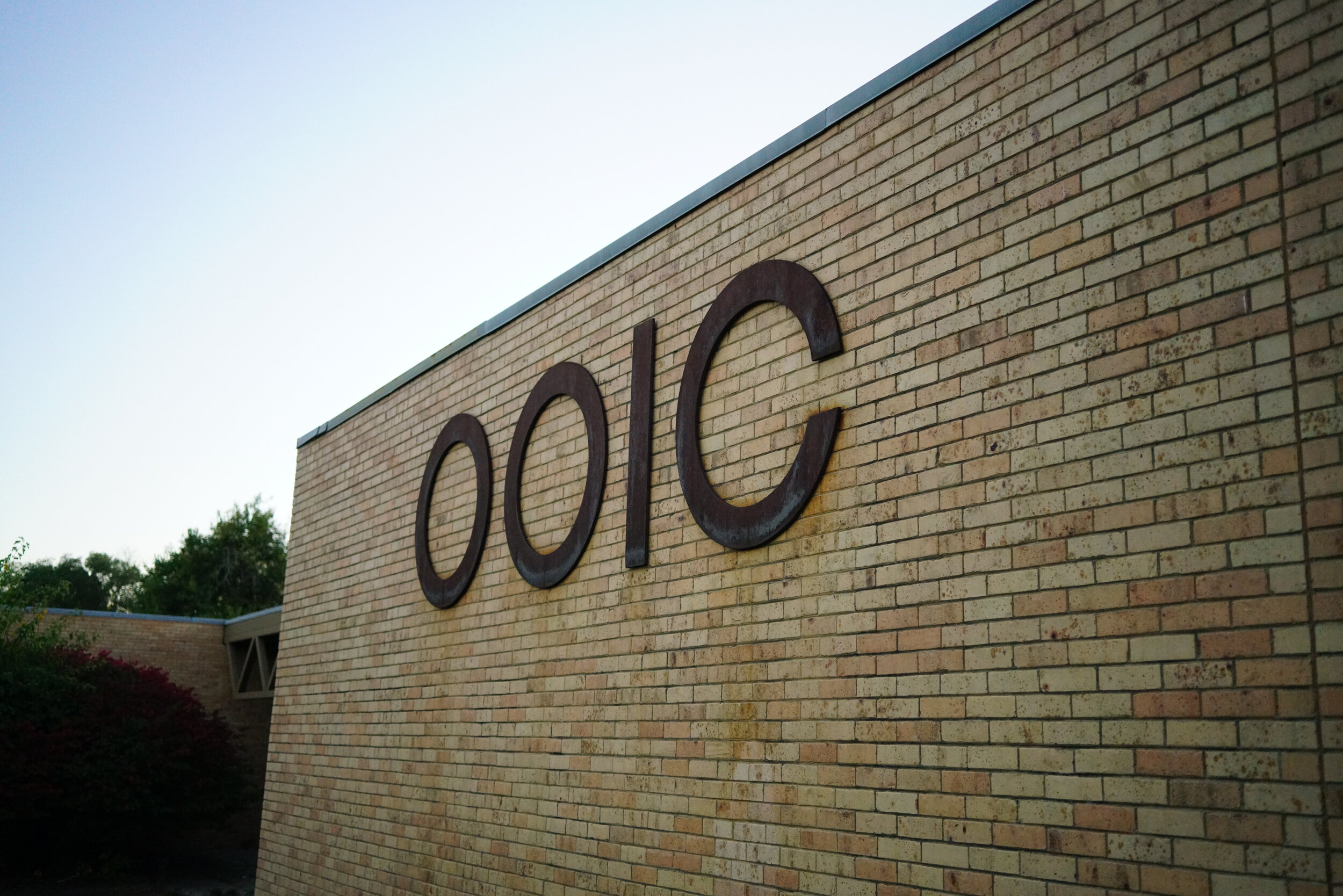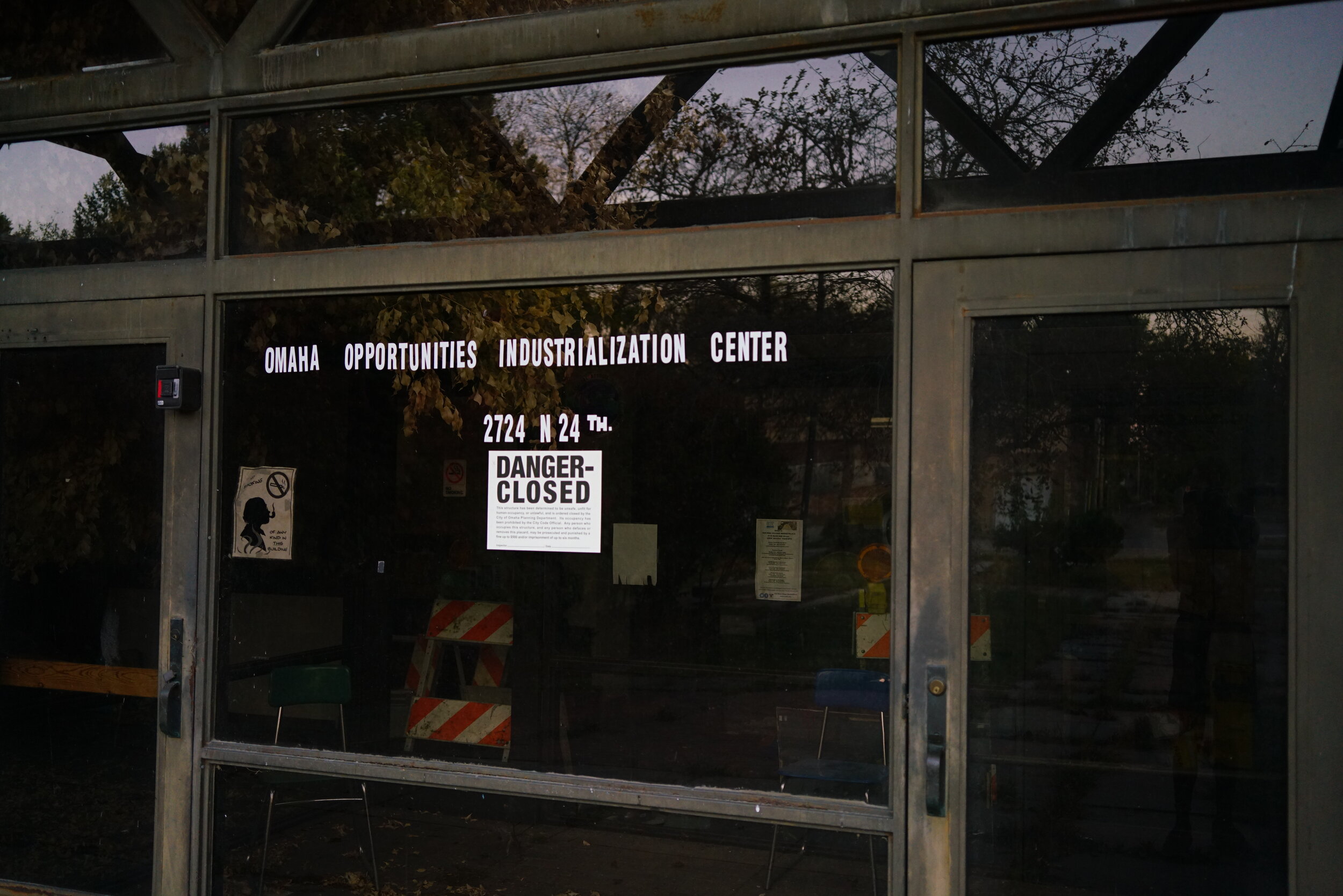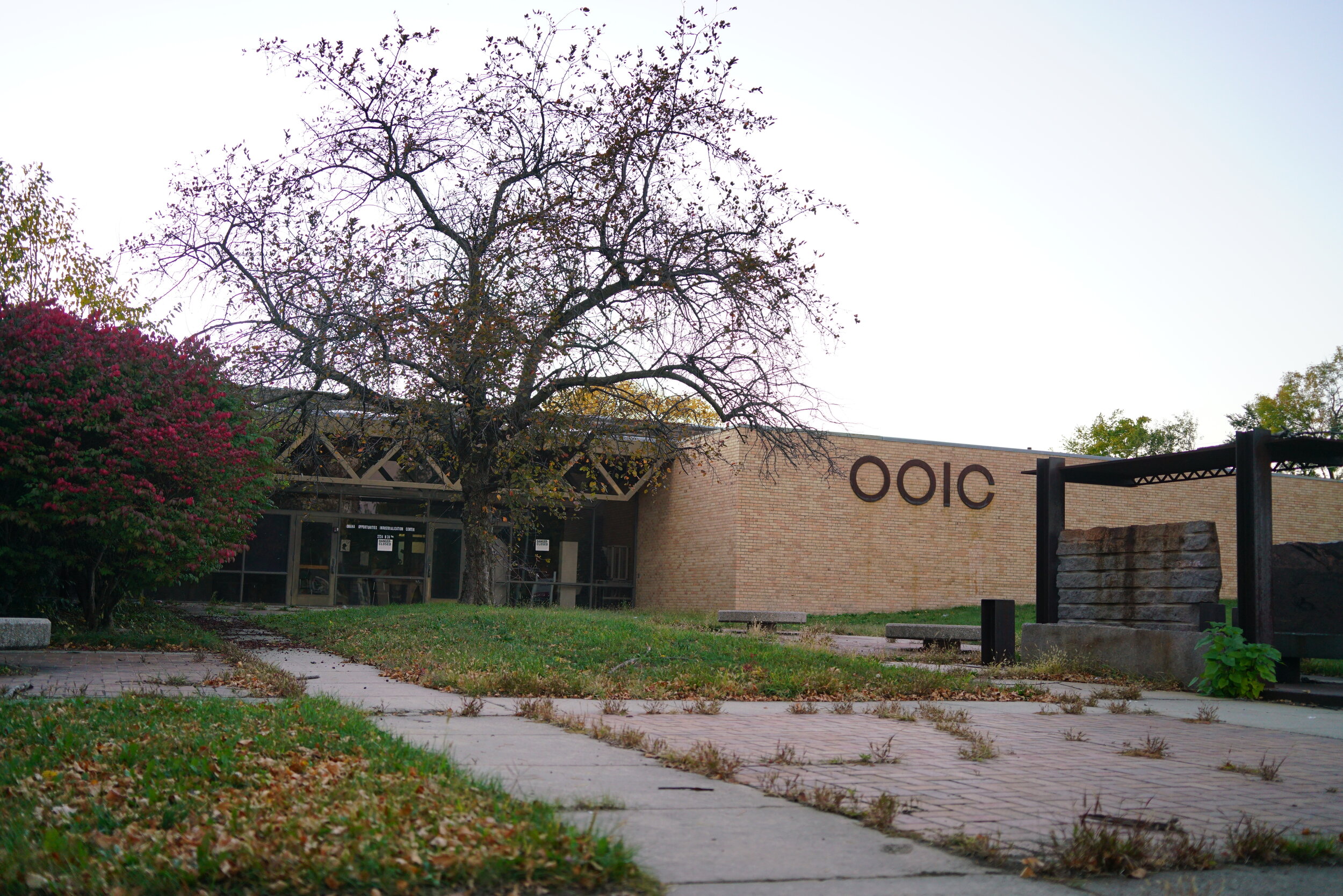An Opportunity to Renew OIC and Rebuild a Community
With the fate of distressed community landmark Omaha Opportunities Industrialization Center (OOIC) in the balance, a group moves to launch a new OIC in town.
by Leo Adam Biga
An NAI NP Dodge for sale sign planted outside the Omaha Opportunities Industrialization Center building at 2724 North 24th Street last summer became a hot topic of speculation.
The site has been abandoned and declared uninhabitable by the city, for at least four years. The registered nonprofit that operated there is effectively defunct. In its heyday, OOIC offered adult education and training programs and hosted community events.
Omaha was once a model affiliate in the national OIC of America network based in Philadelphia, and opted out long ago. Funding dried up. OOIC owed creditors. There were violations of state and city regulations that brought lawsuits.
Today, tarps drape a section of the building where the roof is compromised. An old sign out front reads: “Did OIC help you? OIC needs you. A new roof … Plz donate.” Boards cover broken windows. The sad state of the building, designed by noted architect Golden Zenon and opened to much fanfare in 1977, has become an emblem for how this once proud, bustling hub, met a sorry end.
Or has it? A small, determined group of residents aim to establish a new OIC presence by working closely with the national office. The group led by Akeydra Hagens began as SAVE OOIC. When she and others first began this revival effort they were under the impression OOIC was still functioning and the building on the verge of reopening. They’ve since realized that assumption was untrue.
Akeydra Hagens, Save OIC
Hagens is a former Mutual of Omaha policy analyst and Omaha Housing Authority asset manager who now has a child care center, Create Child Enrichment Center, with her friend and fellow community activist in the cause, Krystal (Curry) Flowers. Other members are entrepreneur Leo Crawford, who with his wife owns and operates Lothrop Childcare Center under their Crawford Community Development Corporation, and NP Dodge realtor and property manager Melisha Potter.
Initially, perhaps as soon as this year, the group looks to host GED testing, business and entrepreneur workshops and skills development. These early offerings will unfold in a community space at 3000 Farnam Street.
Plans call for the addition of more programming over time.
While the group is purposely disassociating itself from the former OOIC, it doesn’t want to make a complete break from that organization, which has a rich legacy bound up in the 29,000 square foot, single-story building that housed its operations. The group hopes to obtain the building and bring it up to code. Having a touchstone where people attended classes, meetings, graduations and home-going repasts would provide continuity with OOIC’s better days.
Though the actors involved in this effort lack personal history with the center, they hear from many folks who do.
“A lot of people are saying that’s where I got my first job,” Flowers said. “That’s an important milestone in their life that stays with them. A lot of people I’ve talked to say their parents attended OOIC to get job training or development or they were an employee. A lot of people are like, ‘What’s going on? We can’t lose the building,’ because it has significance-importance in their life.”
Krystal Flowers, Save OIC
“I was already committed before I heard those stories, but those were vital stories and experiences I heard from people that definitely contributed to my passion.”
Claiming the building would keep a landmark in the hands of the Black community, a sensitive subject these days given the many Northeast Omaha properties owned by outside interests and the City of Omaha’s recent revocation of the lease held by the former management of the Love’s Jazz & Arts Center.
“The reason I feel so passionate about it is that it (OOIC) is one of the last standing landmark buildings owned by African Americans in the community, and we need that. Our community needs to see that representation,” Flowers said. “We need this type of center, these types of programs in North Omaha, where our residents can go without having to drive clear across town. We don’t want to see this building get torn down or turned into something else.”
“We wanted to see if we could get the building before Susie Buffett or everybody else that’s buying up North Omaha,” Hagens said. “We wanted to beat them to the punch and see if we could gather our resources as a community and keep ownership of it.”
Melisha Potter, NP Dodge Real Estate
But as Hagens and Flowers learned, the building’s fate is an open question given its condition and pending legal action to prevent its sale. They were once prepared to work with the OOIC board until discovering the organization was inactive, the building a wreck and the board facing a judicial dissolution action by the Nebraska Attorney General in Douglas County District Court.
Questions remain that Hagens seeks answers to:
“The building sits on city land. The state is involved. Are they interested in the building? Are they interested in the land? Are they willing to let it go? Is it going to be a battle? Is there going to be a lot of politicking involved? We did find out the city is willing to sell the land. So that was good news.”
Despite its tenuous position and against the expressed instructions of the state attorney general, the OOIC board listed the building for sale and accepted bids. The local interest group led by Hagens was among the entities that made a bid for the building. The OOIC board recently signed a purchase agreement with Vaughan Chatman, a native Omahan in California who wants to locate a for-profit solar industry business he owns at that site.
Chatman said he’s prepared to assume the full cost of any building repairs-renovations. The agreement’s validity awaits court rulings. The dissolution action followed a 2015 settlement reached between the state and the OOIC board that the state alleges the board violated. An October 19 filing asks for a temporary restraining motion to require the building only be sold with oversight from the state and city.
EDITOR’S NOTE: The State Attorney General’s office declined to comment for this story.
OIC of America
Hagens’ group initially sought to work with the OOIC board to correct the administrative-management issues cited by the state. “When the board gave us some pushback, we went to OIC of America.” said Hagens.
The national office lost all contact with its former affiliate. Hagens’-led group has since been accepted as an official OIC of America interest group. The network counts 30 affiliates nationwide “They’re willing to help us launch a new OIC organization here. Now that we have their support, we’re a little further along than just hope,” Hagens said. The local organization is filing for 501c3 status.
OIC of America president-CEO James Haynes sees potential.
OIC of America President–CEO James Haynes
“The thing that impressed me most about this group is that they reached out to us,” he said. “This group came to us with their memories of what was and what they felt was needed in the community. And I was personally moved that during a time of social unrest and systemic racism these people were able to stand up and say to a national organization such as ours, what can we do to continue to provide services because the services are needed,”
National OIC helps struggling affiliates right themselves,
“We’ve had affiliates struggle with fundraising and being able to keep their operations going. When we are aware of those situations we do everything we can to ensure they continue to operate and stand on their feet, even if they have to on occasion regroup. In finding their way back, in many cases they return stronger than before,” said Haynes, who came from Johnson & Johnson to rejuvenate a lagging OIC of America three years ago.
Affiliates have left the network for many reasons but “this situation in Omaha is a rare one,” he concedes between the ex-affiliate in disarray and an interest group trying to replace it.
The wild card of a former OIC center in play adds another twist. Several parties have shown interest in the site, but their plans don’t meet the open community concept that the local group advocates.
All for one, one for all
“We want any nonprofit, grassroots organizations that want to be involved to be involved,” Hagens said. “We don’t want to cut anybody out.”
Whether OIC is re-birthed in the building it called home or elsewhere, she said, “There is a need and value to our community to bring OIC back. OIC has been gone for a while. Bringing the spirit of OIC back to the community and giving young people and adults something to do and to look forward to will benefit us in the long run. There’s not a lot of unity in our community. I feel like we need something in the community to be like, ‘this is ours’. We want to build it up for us, by us. We want to rebuild that sense of community that I feel has been lost.”
She adds that a vibrant OIC with stellar adult ed and workforce development programs, including high tech training, can give folks another reason to stick in Omaha. “We’re trying to rebuild something here to make them say this is home – I want to be here and I have a reason to stay.” Or come back.
Leo Crawford, Save OIC
Said Leo Crawford, “I think that community vibe is alive, but we’ve got to give it a central point to bring it somewhere, and I think OIC can bring that back. I’m a bit of a dreamer, so as a dreamer the possibilities of building something and leaving something after I live this world enchants me. I remember coming up as a young man and all the opportunities that were there at OIC, it was active. You could see people coming in and out, involved. It was just part of North O. And then not seeing it anymore was sad. It would be great to have some of those opportunities we had back then.”
OIC is based on the principle of self-determination preached by its founder, the Rev. Leon Sullivan, and Hagens emphasizes that the OIC of Omaha she envisions will advocate the same.
“I study people like Marcus Garvey, Malcolm X and Leon Sullivan. They promoted Black empowerment. They told Black folks to lead our own, teach our own, build up our own, and become self-sufficient,” she said. “I’ve heard stories about how valuable OIC programs and job training were. They built-up people, taught them different trades so they could be economically independent and provide for their families.
Bernice Dodd, Bob Kerrey, and Charles B. Washington, Omaha Public Library Archive
“OIC of Omaha will be all about building up families and empowering individuals to be self-sufficient.”
OOIC was founded in 1966 from a national movement centered around Black empowerment. Rev. Sullivan was a civil rights activist who successfully campaigned to open employment opportunities for African Americans in Philadelphia, where he was pastor of Zion Baptist Church. Though OIC began small it eventually found federal funding to create a network. Omaha became one of its first and most successful affiliates.
“Elders who’ve been around a long time in the national office told me Omaha ran really good programs. It was really an example of making community connections,” said Haynes.
The woman who ran OOIC from nearly its start through the early 2000s, the late Dr. Bernice Dodd, he said, “was a person of high integrity and revered.”
By the 1990s OOIC was mired in debt, no longer offering once core programs in welding. computers, home repairs, retail sales, and banking. Much less, GED and life skills classes. Its last training program, in nursing, ran afoul of the state in the 2000s by conferring certificates without proper accreditation.
That mismanagement and dysfunction doesn’t change the fact OOIC reportedly trained and placed some 20,000 individuals.
Alfonzo Robinson, Veteran OOIC Board Member
Veteran OOIC board member Alfonzo Robinson wants to keep alive the legacy of OIC “as an organization that educated people and prepared them to go out and work.” However OIC is reconstituted here, he said, “There are still things it can do in the community that are viable, that do lead to people’s lives being improved. Preparing them for employment. Giving them the skills-tools to open their own businesses. Improving standard of living, those are the kinds of things we want to see happen.”
Regardless of OOIC’s present travails, he said, “OIC should continue because OIC is bigger than any one person or any board. OIC is about this community and what this community is willing to do for itself. This community was willing to not only establish an organization but to grow that organization. It’s also willing to clean up that organization if it needs to be cleaned up.”
Robinson suggests part of the OOIC board’s seemingly defiant and preemptive actions of late were to test the waters for how serious the community is about keeping OIC. He’s encouraged by what he’s seeing, even though it likely spells the end for OOIC.
“The fact there are people coming to the table and there are ongoing conversations. The fact that when people heard about the sale of the building there was community concern. The fact that you still have members of the community that are hanging on in some way after devastation and loss. What I’m seeing taking place within the community is something I’ve longed for, OIC was a movement and there is a movement happening even now.”
He’s aware of community concerns around OOIC’s failure and suggests the community owns some blame, too.
“People are wanting to know how it got to this point, is it too late, is there anything we can do at this point. I often put those questions right back to the community because things didn’t get that way overnight. OIC as a movement, as an organization, as a pivotal entity in the community didn’t get to its (present) state without the community forgetting about OIC and not coming to the aid of OIC. And so when you do a lot of taking out but not much giving back, it makes it challenging for that organization to continue to operate.”
Photo: Cut Steel Letters spelling OOIC - October 2020 | Dawaune Hayes
A way ahead
Besides new leadership and administrative pieces, Leo Crawford acknowledges any new OIC must build partnerships with key community stakeholders such as Metropolitan Community College and the University of Nebraska at Omaha.
“In some shape, form or fashion, we have to feed into those systems,” he said. “We’ve got talent, we’ve got money, we’ve got ambition. We’ve got all that here. What OOIC didn’t do was connect to the young generation with relevant programs. Maybe what happened was supposed to happen so we could rebound and rethink this.”
Robinson agrees.
“We know things don’t always happen in the time we expect them or in the way we expect them to,” he said. “If ever there was a time and opportunity for reinventing how we do things, it’s now. These are pivotal times for being industrious in our thinking and how we operate, in what things are going to look like, in being cutting edge and allowing individuals to come in with creative ideas. This is prime time for all that and so it’s the perfect time for resurgence.”
“With our experience and history, combined with the processes to make it go,” Crawford said, “we can feed this thing to make it sustainable. We’ve got the motivation, the drive, the determination.”
“That’s why I remain hopeful,” Robinson said. “What I see is the spirit of the community being reactivated. Without the community, there is no OIC. There are processes involved with organizations existing, going away or even being resurrected. All those things are just different steps. But what’s necessary for any and all of that is you have to have like-minded individuals moving in those areas.”
OIC of Oklahoma County executive director DesJean Jones
OIC of Omaha’s ambition to be an OIC of America affiliate will be a journey. “It’s a process to be officially affiliated with them,” Krstyal Flowers said. “They’re very encouraging, very positive. They’ve stood by us since day one as we work on strategy and planning around structure and programming. They’ve given us networking opportunities as well to help us with our mission.”
OIC of America’s James Haynes, his staff and board tell it like it is.
“We’ve been clear with them, ‘Hey, you’ve got to raise your own money, you’ve got to work at putting together your own organizational structure. We’re really interested in ensuring that financially they will be stable and that their leadership understands what it takes to be successful,” Haynes said.
“It’s a fairly involved process with a focus around longevity. You do not want to do something that will not sustain itself. If you’re not building it for the long term and you don’t have a strong plan for where you’re going, it won’t last. And we’re not interested in that. We need to make sure they have the wherewithal to get it done. We’re working with them on what they need.”
On the road to affiliate status, he said, “They’ll have direct access to us, to me. They’re listening, they’re attentive. They know it’s going to be hard. I’m satisfied with the work they’re doing. I think they’re off on the right path.”
Haynes has assigned OIC of Oklahoma County executive director DesJean Jones as OIC Omaha’s mentor-coach. “She is operating a very successful program and she’s helping Omaha with program choices and organizational guidance,” he said, adding, “The idea is for the Omaha group to see how it’s done in another area and then live into the values of our organization.”
Jones has worked with the Omaha group since August. Priority one, she said is “getting them to drill down on what the needs in the Omaha community are and then crafting programming to meet those specific needs.” Making those assessments, she said, means due diligence across all sectors and stakeholders. She senses the group is in it for the long haul and for the right reasons. “Core to the mission is advocacy as the voice of the adult learner population.”
“Their understanding now is very different than what it was 90 days ago,” Jones said. “They’re realizing this is more than just rebuilding what was. This is really creating something new and avoiding some of the pitfalls that existed before. They have taken up that mantle.”
A downward spiral
Unlike the how-to blueprint OIC of America provides the group, the same cannot be said for OOIC, whose board has not shared specifics as to how things went astray.
“If we were able to learn from what brought the decline it would help us be able to say, ‘okay let’s not make those same mistakes,’” Hagens said. “But we feel we don’t get that transparency. We’re still like, ‘What exactly happened?’ We still don’t know.”
Photo: OOIC October 2020 | Dawaune Hayes
Robinson and fellow board members have recently been advised by legal counsel not to comment publicly. But earlier this fall Robinson did address with NOISE, albeit vaguely, what transpired.
“All those resources in place to help OOIC fell away,” said Robinson, adding that in the process it lost the leverage and expertise of board members and advisory committee members who could help steer management through crises.
He painted a picture of an organization losing control as new trades-workforce development players in the community siphoned support. OOIC lacked the means to implement competitive new programs. A 1996 Omaha World-Herald story noted an over-reliance on federal funding hurt OOIC when that funding stopped.
Robinson didn’t mention mismanaged monies, including a $200,000 Community Block Grant administered by the city that OOIC is obliged to pay back, along with funky bookkeeping, unaccounted fund transfers, undocumented meetings, as detailed by the state.
The suit against the OOIC board refers to missing records, a dearth of meeting minutes, lax measures to protect the building, which has been vandalized and allowed to deteriorate, so much so that its assessed value decreased from $1.4 million to $215,000. A perpetually leaking roof (a problem going back decades) has caused severe damage inside, including mold. Scrap thieves have gutted the building of its electrical and plumbing hardware.
The negligence has turned one of North O’s architectural gems into a horror show.
“I can’t even remember the last time I was actually physically in that building,” Robinson said.
OOIC was already beset by problems when its longtime ED, Bernice Dodd, retired. Things unraveled even more in her absence and under the leadership of the late Bobbie Davis, and most recently, Cynthia Jenkins.
From what Haynes has been able to piece together, “The leadership started to turn over. The thing that happens is that people like Berniece Dodd are so ingrained within the community, they represent the face and brand of the organization.” When someone like that leaves and there’s no successor prepared to step in, he said, situations like the one in Omaha can occur.
Meanwhile, the Omaha interest group is taking meetings with Haynes and being coached up by DesJean Jones. The group’s also in contact with both the state and city to stay abreast of the building’s status. Otherwise, Akeydra Hagens and her team are trying to assess needs, identify potential board members, and coalesce support.
“We’re trying to create a board of different professionals and backgrounds and trying to get different organizations involved,” Hagens said. “It’s a lot. We’ve had so many meetings. A lot going on. But it’s coming along.”
Expressions of support, she said, have come from various individuals and organizations.
Taking stock and moving forward
Given a groundswell of interest in bringing OIC back from the dead, Robinson wonders if the state’s action is necessary.
“There’s various steps a regulatory body can take – steps of correction, of punishment. With the community basically reawakening and making their voice heard it begs the question is this whole dissolution necessary. Or what could still be done even at this point if we wanted to fully maintain the legacy of OIC? The community is saying, yes, this went on, we see this was happening, we know there was a gap in there, things didn’t go well, and we’re here to find out what can be done as a community to move things forward.”
“That’s what I’m hearing and seeing. The reason why that is vital is that you’re talking about a former anchor or pillar in the community. The community is saying ‘we see the value in this – this is not something we are willing to part with.’ Even though you may say we’re taking this away, the community is saying, try if you will, we’re still going to be here.”
Which brings us back to the building.
”The point is, make it about the community and the programming, less about the building. You can provide your programs-services in other places. They have a solid Plan B they’re already working on,” said James Haynes.
Photo: OOIC Building- October 2020 | Dawaune Hayes
“We’re thinking about a community investment trust, where an organization like ours buys it and allows the community to buy in and own shares in the building,” said Hagens.
She notes, per the state’s own filing, the law allows the transfer of any remaining assets from a dissolved OOIC or from the sale of the building to an organization with a similar purpose and mission, such as OIC of Omaha. “So that is our goal,” Hagens said.
But Haynes cautions to not get “too hung up on the building.”
“I told the team, ‘Let’s not make this about that building.’ Would you love to have it? Sure. While you want ownership of assets and your own facilities - we preach that – if you don’t get that building you have to be prepared to do something without it. The point is, make it about the community and the programming, less about the building. You can provide your programs-services in other places. They have a solid Plan B they’re already working on.”
Whatever happens, Krystal Flowers said, “I want the community to know we’re doing this for them and we need their support – physically, mentally and financially. Even if you can’t help financially, we need your support volunteering when the time comes. We need help just spreading the word, spreading awareness, and in every way possible to complete this goal.”
Messaging will be critical.
“Probably a significant challenge they will face is creating distance between the previous OIC there and them, while simultaneously communicating it’s part of OIC of America,” said Jones.
One thing from the past the new group hopes to replicate is the coalition of support that allowed OOIC to raise the funds to construct the building from the ground up. Support this time will be needed to launch programs and perhaps rehab the building.
As Hagens posted online, “We need our community organizations, churches, government officials, business owners, veterans to work as a collective with one agenda: ”HELP US, HELP OURSELVES!"


